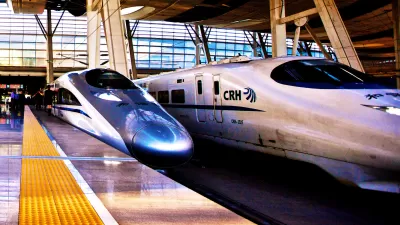The opening of the 1,200-mile Beijing to Guangzhou high-speed rail line marked the latest milestone in "one of the world’s largest and most ambitious infrastructure projects." The longest such segment in the world takes only 8 hours to traverse.

At a speed of 300 kilometers, or 186 miles, an hour, China's latest infrastructure marvel covers a distance similar to that between New York and Key West, Fla. in only 8 hours. Amtrak trains from New York to Miami take 30 hours. According to Keith Bradsher, the latest milestone - which means the country has completed 5,809 miles of high-speed lines in just over four years - is not just significant for train enthusiasts; it's having a notable impact on China's economy and environment.
"Lavish spending on the project has helped jump-start the Chinese economy twice: in 2009, during the global financial crisis, and again this autumn, after a brief but sharp economic slowdown over the summer," says Bradsher. "The hiring of as many as 100,000 workers for each line has kept a lid on unemployment as private-sector construction has slowed because of limits on real estate speculation. The national network has helped to reduce air pollution in Chinese cities and helped to curb demand for imported diesel fuel by freeing capacity on older rail lines for goods to be carried by freight trains instead of heavily polluting, costlier trucks."
"But the high-speed rail system has also been controversial in China. Debt to finance the construction has reached nearly 4 trillion renminbi, or $640 billion, making it one of the most visible reasons total debt has been surging as a share of economic output in China, and is approaching levels in the West."
FULL STORY: China Opens Longest High-Speed Rail Line

Alabama: Trump Terminates Settlements for Black Communities Harmed By Raw Sewage
Trump deemed the landmark civil rights agreement “illegal DEI and environmental justice policy.”

Study: Maui’s Plan to Convert Vacation Rentals to Long-Term Housing Could Cause Nearly $1 Billion Economic Loss
The plan would reduce visitor accommodation by 25% resulting in 1,900 jobs lost.

Why Should We Subsidize Public Transportation?
Many public transit agencies face financial stress due to rising costs, declining fare revenue, and declining subsidies. Transit advocates must provide a strong business case for increasing public transit funding.

Paris Bike Boom Leads to Steep Drop in Air Pollution
The French city’s air quality has improved dramatically in the past 20 years, coinciding with a growth in cycling.

Why Housing Costs More to Build in California Than in Texas
Hard costs like labor and materials combined with ‘soft’ costs such as permitting make building in the San Francisco Bay Area almost three times as costly as in Texas cities.

San Diego County Sees a Rise in Urban Coyotes
San Diego County experiences a rise in urban coyotes, as sightings become prevalent throughout its urban neighbourhoods and surrounding areas.
Urban Design for Planners 1: Software Tools
This six-course series explores essential urban design concepts using open source software and equips planners with the tools they need to participate fully in the urban design process.
Planning for Universal Design
Learn the tools for implementing Universal Design in planning regulations.
Smith Gee Studio
Alamo Area Metropolitan Planning Organization
City of Santa Clarita
Institute for Housing and Urban Development Studies (IHS)
City of Grandview
Harvard GSD Executive Education
Toledo-Lucas County Plan Commissions
Salt Lake City
NYU Wagner Graduate School of Public Service


























